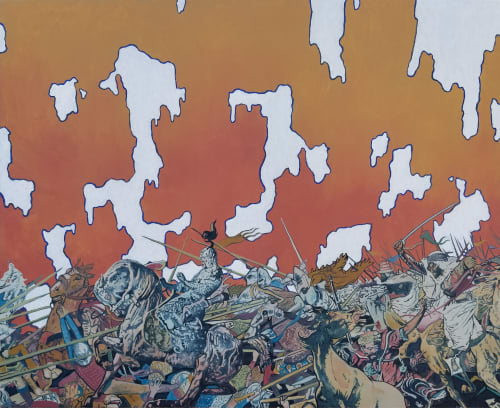Mere days before acclaimed environmental journalist Jeff Goodell picks up the phone to talk about the Blanton Museum of Art’s If the Sky Were Orange: Art in the Time of Climate Change, a special exhibition running Sept. 9, 2023—Feb. 11, 2024, the skies along the East Coast actually do turn orange. Residual smoke from the Canadian wildfires cast the Northeast, from New York City down to Chicago and Detroit, in an eerily auburn haze, the result of longer wavelengths from smoke particles bouncing around the atmosphere while also creating some of the worst air quality in the world.
“The exhibition’s title came from a story that a scientist told me a decade ago when I was on a research vessel in the north Atlantic,” Goodell says. “What would it take to wake people up and make them aware of what’s happening to our world? If CO2 stained the air orange or purple. But it seems like we don’t even need that anymore to see the effects.”
Co-curated with Carter E. Foster, the Blanton’s curator of prints and drawings, the two-part exhibition also draws its name from Aaron Morse’s Cloud World (#3), a 2014 painting with neon orange clouds blotting a stark blue sky above roiling seas. This anxiety over climate change is nothing new, Goodell says. His seventh book on the topic is about to be released, and he has covered climate change for more than two decades for Rolling Stone. But this exhibition is a chance to combine words with images, science with art, pairing his writings and those from nine of his colleagues with arresting pieces from 10 contemporary artists.
“Carter asked me to go back through the museum’s collection and reinterpret a number of their pieces in the context of climate change,” says Goodell. “He pulled several hundred pieces that he thought I might find interesting—works not done with climate change in mind, but that nonetheless represent and echo the theme—and I narrowed it down to about 35-40 from the museum’s permanent collection to write about.”
The exhibition was also born from a conversation Goodell had with his wife, Simone Jamille Wicha, who happens to be the museum’s director. They had been talking about the culture gap that exists in the conversation of climate change, how the energy and science worlds talk often about it but the rest of the world doesn’t. Wicha had the idea to build a dialogue between writers and artists, to frame the topic in a social and cultural context.
“I’m very excited to reach a new audience and provoke them to think about energy and climate change,” Goodell says, “To see it not as an economic issue or a partisan or religious one, but as part of this larger story about our relationship with nature.”
For his first exhibition ever, Goodell reached out to fellow writers and experts in the field. Among those contributing their words are Elizabeth Kolbert, who won the Pulitzer Prize in 2015 for her book The Sixth Extinction, and Julian Brave NoiseCat, a member of the 2021 Time100Next list for his advocacy. On the artist side are such names as Cannupa Hanska Luger, the New Mexico-based artist behind the Mirror Shield Project protesting the Dakota access pipeline, and Sandra M. Sawatzky, who gained fame for her 220-foot tapestry charting the long, frustrating, and often violent history of oil.
Goodell points out that mounting such an exhibition in Texas might not just be controversial—it’s necessary. He comes prepared with the fact that Texas is a leader in wind and solar power, and it’s these renewable resources that are making it possible for our air conditioners to run nonstop throughout scorching, humid summers. An entire wall of the exhibition will be devoted to a timeline of climate change benchmarks from the past 3000 years, he reveals, with another wall showcasing an essay by a UT professor about Texas’ role in energy history.
“As we’re seeing with the current heat wave, plus a large coast that battles storm surges, hurricanes, and rising sea levels, Texas is very vulnerable to climate change,” Goodell says. “The idea is to help people understand the idea of climate change and our relationship with nature didn’t happen six weeks or even 10 years ago. How we think about these things is as old as humanity.”

